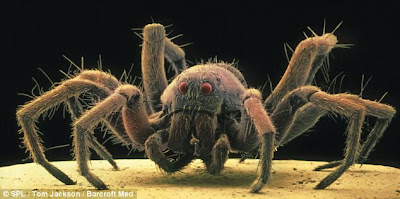 Coloured scanning electron micrograph of a bluebottle fly
Coloured scanning electron micrograph of a bluebottle flyThey may look like gruesome monsters from a horror film but these tiny creatures inhabit our homes, clothes and even our bodies.
Showcased in an extraordinary new book, 'Micro Monsters', features over 80 of the world's most horrible insects and microscopic beasts in incredible 3D images.
UK author and trained zoologist, Tom Jackson, spent three months compiling the eye-watering images to create the book.
 A yellow dung fly appears to stare into the microscope
A yellow dung fly appears to stare into the microscopeUsing some of the most up to date technology to hand, scientists coated the tiny creatures in gold and deep froze them in liquid nitrogen.
Firing a beam of electrons at the subjects from a scanning electron microscopy, the incredible detail can be seen in these results.
Revealing how invertebrates even look like they have expressions, as shown by the smiling ragworm head with its many tentacle like protrusions crowning what looks to be its face.
Even the dark side of the cute-looking garden variety ladybird is shown as it ferociously consumes desperately scattering aphids on a plant stem.
Other highlights include a colourful coiled sandworm into its hairy body, the bared fangs of a hook worm ready to feed, a head louse tending to its egg on a human hair and an amazing portrait of a drosophila fruit fly.
 A human head louse with an egg is enough to make your head itch just by looking at it
A human head louse with an egg is enough to make your head itch just by looking at it'I wanted to get together all the most gruesome and beastly pictures I could,' said 38 year-old Tom from Bristol. 'This book shows everything that's around children, in the home, the garden and the playground.
'Things they will already be familiar with such as worms and spiders, but many they will not be aware of like parasites and dust mites.
'The point is they will be able to relate to these images yet be amazed by the new perspective it gives them.' Mr Jackson, who has written over 80 books for adults and children, explained that his new Micro Monsters photographic book is an opportunity for him to show what's going on around us that we cannot see it with our own eyes.
'Some of the best science at the moment is going on at this level but this type of work often gets overshadowed by some of the literally larger projects.
'Once you get up close you can see what's going on.' A scanning electron microscopy is used to fire a beam of electrons at the subjects, in this case insects and other mini-beasts.
 Even the individual hairs on the legs of this parasitic wasp are visible
Even the individual hairs on the legs of this parasitic wasp are visible A European hornet appears to glower into the camera
A European hornet appears to glower into the camera A common house spider looks like it is wearing a glum or bemused expression in this frightening shot
A common house spider looks like it is wearing a glum or bemused expression in this frightening shotElectrons have shorter wavelengths than lights waves so by using them smaller objects can be captured.
'What's different about the techniques we've used is to scan them in 3-D so we can make the subjects really come alive.
'We've coated them in gold and deep frozen them in liquid nitrogen to record the images.
'The pictures I'm most pleased with are the close up portraits of insects that show the intricate details of their eyes, mandibles and even the hairs on their heads.
'I've tested the book out on my son Ned and it hasn't given him any bad dreams, in fact he loves it.
'In particular Ned likes like the nasty worms.
'It's always a relief to finish a book and greatly satisfying to see the finished product.
Micro Monsters is shortly to be launched in the UK by Amber Book.
 An earwig on a leaf looks rather more like a terrifying scorpion in this close-up image
An earwig on a leaf looks rather more like a terrifying scorpion in this close-up image Two water bears (or tardigrades) are seen crawling on a leaf
Two water bears (or tardigrades) are seen crawling on a leaf An aphid (greenfly) feeding on a leaf glows bright green under the electron microscope
An aphid (greenfly) feeding on a leaf glows bright green under the electron microscopesource: dailymail















+The+quirky+new+calendar+that+uses+pets+to+spoof+the+rich+and+famous+1.jpg)


+1.jpg)